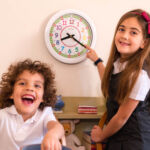
It’s been over 30 years since we first developed our EasyRead time teaching system, and since then we have delivered our learning clocks and resources to schools and households all over the world.
Our unique range is used every day by parents, teachers and children in over 20 countries, and we love hearing all of your feedback! We want to say a big thank you to all of our customers who have taken the time to leave a review, so let’s take a look at what you all love most about our clocks!
Our learning clocks for the home
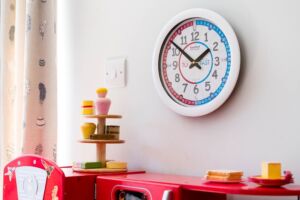
In just three easy steps, anyone can learn how to tell the time. Every clock in our range includes all the information that children need in order to learn to tell the time (including every hour of the day and every minute of the hour) thanks to our EasyRead design that makes learning easy and accessible.
All you need to do to know you’ve made the right decision in choosing an EasyRead learning clock for your little one is to take a look at our reviews!
“I bought a wall clock for our granddaughter and we are very pleased with the product. At 13 months old she seemed to prefer the leaflet which came with it and then we realised that she was pointing to the pictures of the ERTT wristwatches and then to my watch.
Learning starts at any age and I guess we’ll be buying the watch in a few years!”
– Helen Wray
“My 5 year old can now (mostly) read an analogue clock!
This has been a fantastic tool in helping my daughter tell time. It took only a few minutes to teach her how to read it and now she can easily tell me what time it is while reading this clock..”
– TC
“Helpful in the morning for the kids to know the time before school and then develop from their o’clocks. Colour coding helps and my 6 and 8 year old both are building their skill as they tended to just ‘ask Alexa’ beforehand.”
– NR
“Such a great clock. I purchased it for my daughter who is learning to tell the time. The past/to concept has made the learning process so easy!
I will be purchasing for my other kids when they reach an appropriate age too.”
– Sarah
“Brilliant! Took 2 minutes to explain to my son. This is what we needed years ago.”
– AC
Classroom learning clocks
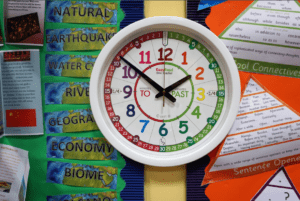
For schools and nurseries, we offer classroom and playground clocks that are designed to support the learning of children from the age of 5. Just like our clocks for the home, each one is available with the 12/24 Hour or Past & To method, and is designed to support the learning of an entire classroom, but don’t just take our word for it!
Check out what teachers just like you love about our classroom clocks!
“The children found it so helpful to learn about which half of the clock shows past and quarter, including all the different intervals, because it is colour-coded! I will definitely be putting this up in my classroom!”
– Miss Rashid
“Telling the time is obviously such a key foundational maths skill, but also one that is really tricky. But thanks to Easy Read Time Teachers’ range of products it has become so much easier.”
– Miss Knight
“Easy Read Time Teacher has this amazing wall clock which I just absolutely love: it splits up the concept of time really simply and it’s a great visual for children to use.”
– Miss Vanbeck
“This is the best clock I have found for teaching the time, there is nothing comparable. It allows learners to begin with all the information required then gradually remove bits until they are using a standard clock.”
– Sam
Thank you!
All of our reviews are independently verified by Review Biz, so thank you all for letting us know what you love about our learning clocks.
Want to see what all the fuss is about? Click here to view all our EasyRead clocks and find the right one for your little one (or even for yourself!).

Has your little one finally learnt how to read the time on their time teacher watch? Now comes the really tricky part of getting them to look after their very own EasyRead watch!
Our time teacher watches are suitable for children ages 4+, which also means they’re suitable for all of their daily activities. With a stainless steel back, non-allergenic plating, and a washable nylon strap, our EasyRead watches are ready for anything your little ones have planned, but there are some steps that you can take to keep them in their best condition and make sure they last as long as needed.
Choose our waterproof watches
Our EasyRead watches are water resistant and can withstand splashing, but not total immersion (unless you opt for our waterproof watches). This means that your little ones don’t need to take them off when washing their hands or walking to school in the rain, but continued exposure to water will damage even the most robust EasyRead system, so make sure that they always take it off before showering or bathing.
We all like to think that we can trust our little ones to be responsible for their watches, but if your child is active and outdoorsy and you’re worried that they’ll use their watch around water, why not treat them to one of our waterproof versions? These watches are waterproof up to 50m and their stainless steel case and scratch-resistant glass means they can be used anywhere, anytime, without becoming too damaged, and also means that it doesn’t matter if your little one forgets to take it off before entering water.
Check the strap
Our watch straps come in a wide range of colours and designs to suit all different tastes, so you can easily customise your little ones’ watch if their favourite colour changes over time, or if the original strap becomes worn.
Our breathable nylon straps with stainless steel buckles are tough and washable, but they can become worn down through continued rough play or water damage. So, keep ahead of this by checking the strap every week or so, particularly after outdoor activities, or stock up on one or two extra straps to keep at home in case the strap breaks.
Take it off when necessary
Our watches are built to last, but like all accessories, it is a good idea to ask your child to take off their time teacher watch before doing any rough or physical activities.
This includes playing sports like rugby or football in school or helping with manual chores around the house and garden. Of course, this is within reason – we can’t expect them to remember this every time they want to swing on the monkey bars or play tag – but they should take it off before engaging in any activities that are likely to damage the plating or scratch the watch face.
A great way to get your little one to understand this is to compare their watch to a pair of glasses; either their own pair or one that belongs to a family member. Explain that if an activity would require them to take off their glasses, then they should also take off their watch to keep it safe.
Store it safely
Our watches can be used any time of the day or night, but when they’re not in use it’s a good idea to store them in a way that prevents them from accidentally becoming damaged.
As a starting point, watches should never be stored face-down as this is almost guaranteed to result in a scratched surface, so encourage your little one to get into the habit of storing their watch with the face facing upwards. If you’re worried that they’ll probably forget to do this, or you’re trying to encourage them to take good care of their belongings, then invest in a protective case to keep the watch safe when not in use. This can then be stored by their bedside or packed into their school bag to make sure that their time teacher watch is protected whilst they’re out and about and always on hand when they need it.
Remember it’s a tool
A time teacher watch is a fun but educational resource, and it is often the first such tool that a young child will use. So, whilst it is fun to play with throughout the day, make sure you remind your little one that it is much more of an educational tool than a toy and they need to use it properly.
Encourage them to be careful with it, just as they would be careful with school property, and remind them that they shouldn’t let other children try on their watch if they can’t trust them to be careful with it. Having their very own watch also signals to young learners that they are growing up and are trusted to keep their belongings safe, so remind them that if they can look after their watch then everyone will know that they are growing up to be reliable and responsible, and praise them for taking good care of their watch.
Our EasyRead time teacher watches
Do our durable, reliable EasyRead watches sound like a good investment in your little ones’ learning? Check out our full range here, and don’t forget to practice our EasyRead method with them – available for all our Past/To Watches and our 12/24 Hour Watches.
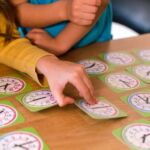
The chilly winter evenings and dark weekends mean less opportunities for outside play but the perfect reason to spend time together inside as a family! So, if you’re keen to make the most of this extra time, why not take this opportunity to make learning how to tell the time fun for your little ones?
From our free downloadable resources to our Countdown to Christmas games, we’ve put together a guide on how to make learning fun this winter, so, gather the rest of the family and take a look!
How to tell the time
Did you know that most clocks and watches only display about 20% of the information that we need to read the time? This means that 80% of the information is missing, making it hard for young children to understand what number each hand is pointing to. On top of this, children often struggle to decide which hand is which, as most clocks have hour and minute hands that are the same length.
In 1992, we decided that children were not receiving the support that they needed to read a clock as there was nothing on the market that specifically addressed these difficulties. This is why we started EasyRead Time Teacher, and also why we developed our simple time-teaching method that explains how to tell the time in 2, or 3, easy steps.
Our method is designed for children of all ages, and works on both 12/24 hour clocks and Past & To clocks, depending on which model your children prefer. So, explore our full method by clicking here, and then read on to discover how you can make this learning process fun and engaging with our favourite time-teaching activities.
How to make it fun!
Now we move on to the exciting part! Our simple process can be used on any EasyRead products from our range, so let’s take a look at what time teaching activities are available to support your child’s learning.
1. Tell the Time Card Games
If you’re wondering how to keep the kids entertained on a rainy winter afternoon, our Tell the Time cards offer hours of fun playing all the family favourite games.
Available in two levels – suitable for ages 5-7 and ages 8-11 – each pack contains 60 cards showing 15 different times that can be used to play all kinds of games. From snap and matching pairs, to buddy-up and bingo, the aim of every game is to match up the times and recognise the different minutes and hours of the day whilst having fun.
2. TwinTime Cards
Another time-teaching game that is popular with children (and adults!) of all ages are our TwinTime cards. Sold individually or in boxes of 10, our cards feature a printed EasyRead clock and moveable hands that let you display any time of the day for a simple learning exercise that also lets you count backwards and forwards, in 5s and 10s, and practice fractions.
3. EasyRead Watches
Don’t keep our EasyRead watches hidden away under the tree until Christmas Day – these brilliant time-teaching tools can get a lot of use in the run-up to Christmas.
If your child has one, or if you’re planning to gift them one, encourage them to use it by asking them how long a particular task will take. You can ask them to make a note of what time they start an activity like brushing their teeth or cleaning their room, and then again when they stop, before asking them to work out how much time they have spent on that task.
This is a great way to add some excitement to the dull daily tasks and to make the most of the exciting festive activities like putting up the tree or baking some Christmas treats.
4. Time Charts
Creating a time chart showing your childs’ daily schedule is a great way to help reinforce the importance of knowing how to tell time in our everyday lives.
Get your little one to create a chart showing what time of day they are expected to wake up, brush their teeth, go to school, and go to sleep, and keep it fun by encouraging them to add their favourite activities in as well such as an after-school club or time with family. This is also a good way to maintain a sense of structure in their daily lives during the holidays and particularly in the run up to Christmas when all sense of time seems to go out the window!
5. Downloadable Resources
Finally, if your budget is a little tight this winter, our free resources are available to print or download on our website. From our Make a Clock activities to our Home Education Day Planner, we have an entire webpage dedicated to keeping your little ones entertained for less, so click here to view our free resources today.
Learning how to tell time with EasyRead
If you’re hoping to make learning how to tell the time as fun and engaging as you can for your kids this winter, our time-teaching method is the first place you should start! Check it out now and get started on planning your engaging activities today.
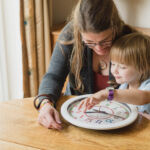
Is your child struggling to read an analogue clock? Perhaps you yourself have had trouble reading the time? For over 20 years, we have been working to make learning how to tell the time on a clock more accessible and enjoyable for children and adults. So, let’s take a look at our two intuitive methods for all learners and how these time-telling processes can transform the way your child understands time.
How to tell the time on a clock
Many children find it difficult to read the time on an analogue clock. This may be something that you have already noticed in your child, or it may be a concern that you are keen to address ahead of the new school year.
We identified these difficulties in children several years ago, and we worked with a group of children to identify the two key causes of their confusion and hesitancy. Both issues come from design flaws on the clocks themselves, as the first is regarding the limited information contained on the face of a clock.
First, regular clocks and watches typically display only hour numbers and some small markings to indicate minutes without actually displaying the 60 minutes within each hour. Whilst this is usually enough information for an experienced time-telling adult to gauge the time, it actually represents just 20% of the information needed to accurately read the time. The remaining 80% – including crucial context like minute details and clear hand positioning – is missing.
The second issue regards the hands of a clock. On most clocks the two hands are often nearly the same length which makes it confusing for people to determine which number to read first. They are also often positioned between numbers, rather than landing on a specific minute marker, which makes it even more challenging to accurately read the time. This lack of clarity makes learning to tell time challenging and frustrating for many children, and for those who struggle with dyscalculia or similar challenges, these struggles can continue long into adulthood.
EasyRead Time Teacher
This is where EasyRead comes in. Our clock face designs carry all the information that is needed to tell the time and each minute of the day is carefully enclosed in separate sections so that the tips clearly point to specific numbers
We also separate the hour and minute sections of the clock into two clear circles, and each hand is enclosed in its own circle to avoid any confusion. So, now that you are familiar with our design, it’s time to take a look at the two simple ways to read an EasyRead clock.
3 step process
Our first method follows the usual process of reading a clock – the ‘past & to’ method. This popular time-telling technique is the one taught in UK primary schools, so if you’re looking to support your little ones’ learning, this is a straightforward method that reinforces their new skills.
Step 1: First, look at the long hand and read the number at the end of it. This number represents the minutes.
Step 2: Next, state whether the minute hand is on the “past” side or the “to” side of the clock. This helps children understand whether the minutes are counting past the current hour or towards the next one.
Step 3: Finally, look at the short hand and read the number at the end to state the hour.
And there you have it! Simple, straightforward, and requiring no guesswork, our structured approach uses all the information available on the clock and makes telling the time an easy game of ‘say what you see’.
2 step process
Perhaps you tell the time another way – as if you’re reading a digital clock? We aim to make learning how to tell the time on a clock accessible for all, which is why we also offer 12/24 hour clocks which only require 2 steps to read.
Step 1: First, look at the hour hand and read the number that it is pointing to.
Step 2: Next, look at the minute hand and read the number at the end.
Say these numbers out loud as you read them to state the current time. For example, if the time is “1:52,” simply say “One, fifty-two.”
How to tell the time on a clock with EasyRead
Which of these methods will work the best for you? Refer back to them as needed and enjoy practising the right method for you with our full range.
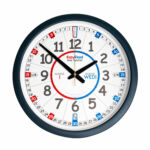
If your child is learning to read a clock for the first time, then they are likely going to have a lot of questions. Whilst the majority of them will probably centre around how clocks work or how they demonstrate the passing of time, your child might start to look outside of their own experience and wonder how different cultures tell time. Different countries and languages can all measure and interact with time in very different ways, so if you or your child are interested in exploring how other cultures learn to tell the time, here is our guide.
Time-telling across the world
Different parts of the world have different, and often unique, ways of interacting with time, shaped by historical, geographical, and social factors. Modern timekeeping is largely uniform due to globalisation and technological advancements which have reduced modern time telling skills to a quick glance at a screen, and so it is easy for us to overlook the importance that time still holds for many cultures across the globe.
Exploring how different people learn to tell the time can reveal a great deal about their societies and the structure of their days, as many local time practices still reflect cultural identities. Whilst in Britain, our timekeeping is primarily used as a way to schedule our daily lives and has little cultural impact, in other areas the way people interact with time can vary depending upon the seasons, the time of day, and any religious holidays or festivals.
These rules, whether clearly displayed across societies or simply implied through practices that have been passed down through generations, nurture the timekeeping traditions of different areas and keep them from fading. So, before we get into a deeper exploration of how cultures across the world learn to tell the time, let’s take a look at how interactions with time differ from country to country.
Interactions with time
Cultural attitudes towards time vary significantly around the world, reflecting deeper values and revealing much about the numerous different ways of life. These diverse attitudes towards time and its passing not only influence daily schedules and social norms but also reflect broader cultural values and priorities, shaping how people interact, conduct business, and manage social relationships.
For example, in countries such as America and the UK, time is viewed as a way to keep track of the different stages of the day and informs which actions we take next, which has resulted in a structured approach to time management and a strong emphasis on punctuality, scheduling, and efficiency. Time in the West exists to keep us on track and manage our tasks, and this strict approach to time is also one shared by several East Asian societies, particularly across Japan and South Korea. These areas often have a considered and measured approach to time, valuing punctuality and structure highly and viewing time as a resource that must be managed wisely. However, it is important to remember that many of these attitudes are unwritten, and can only be observed through daily interactions, rather than through the study of time.
In contrast to these more rigid contexts, where time is money and lateness is seen as an insult or indicative of one’s commitments, many other societies have a more relaxed attitude towards time. Primarily found across Middle Eastern and Latin American cultures, these attitudes are informed more by social factors than strict schedules, and measurements of time are often event related, meaning that the conclusion of an activity is generally more reliant on the judgement of the participants rather than the amount of time allotted on a clock.
By taking the time to observe these different ways of scheduling, planning, and utilising our time, we can explore the different societal and environmental factors that inform our engagement with the concept of time. What may seem unusual, or sometimes rude or wasteful, to one culture is often informed by many centuries of societal development and cultural norms, illustrating the multifaceted nature of time across global cultures. Despite being seen as a universal concept that touches every area of humanity, the ways that we interact with time have been adapted to suit the requirements of different societies across the world: so, no matter where you come from, there is always something to be learned through exploring the different attitudes to time.
Telling the Time
As our understanding of time differs so much depending upon where we come from, it goes without saying that how we learn to tell the time differs greatly as well.
For as long as humanity has been able to observe the sun rising and going down, and the turn of the seasons as temperatures dropped and crops stopped growing, we have been developing ways of tracking it. Ancient cultures such as the Maya and Egyptians developed advanced calendar systems that integrated astronomy and seasonal cycles, which informed our understanding of time and eventually led to the development of a worldwide 12-month calendar based on our planets’ movement around the sun. This shows that the natural progression of time is inherently circular and relies upon continuous natural loops, but over the centuries, we have moved away from astrological ways of tracking time – although there are still cultures who use natural indicators for tracking religious or cultural events.
Time-telling methods vary globally, influenced by cultural, historical, and environmental factors, and these variations remind us that time’s perception is as much a cultural construct as a scientific measure. However, there is one universally accepted and utilised tool that helps us all measure time: the clock.
Clocks
Across the world, clocks are used as a visual representation of the passage of time, and whether we use it to create our schedules or track our time, they are always there to show the hours, minutes, and seconds as they pass.
Throughout the US and Europe, people predominantly use the 12-hour and 24-hour formats on digital or analogue clocks, with many of the historical ways of telling the time long forgotten by the advancement of time-telling resources. The timekeeping practises of many East Asian cultures is also similar to these methods, as they utilise both digital and analogue clocks and the timekeeping system divides the day into 12 two-hour periods, whilst Latin American cultures use the 12-hour format – although often without strict adherence to exact times and with a more flexible, relaxed approach to time.
Both the 24-hour clock and the 12-hour clock represent the same units of time, but the passage of time is displayed in different ways. The 24-hour clock, often referred to as “military time,” is a widely adopted format that eliminates the ambiguity present in the 12-hour clock system by making it immediately clear which part of the day is being referred to. For instance, 18:00 immediately indicates late afternoon or early evening, whereas 6:00 on the 12-hour clock could be early morning or evening and requires the additional specifier of “a.m.” or “p.m.” to clarify. Despite this, the 12-hour format has a long historical identity and is deeply embedded in the daily life and culture of the regions that use it.
Cultural methods
In many other areas of the world, the erasure of traditional methods is not as widespread, and many cultures utilise a blend of traditional and modern methods that reflect their cultural nuances. This is particularly evident in global Islamic cultures, as prayer times are crucial and Muslims are expected to pray up to five times a day. This schedule is maintained year-round, and the yearly calendar also contains numerous religious holidays depending upon the movement of celestial bodies, as the month begins with the new crescent moon in the Islamic calendar, and astrology remains a key focus of their festivals and celebrations.
Similarly, whilst the majority of the Indian subcontinent follows the standard 12-hour and 24-hour clock formats, the landmass still contains rural areas and cultures that utilise traditional time units as cultural measurements. Although they rarely depend upon them for modern-day timekeeping, these traditional and cultural attitudes towards time continue to coexist with contemporary methods despite the rapid global modernisation.
How to tell the time with EasyRead Time Teacher
The enduring popularity of cultural timekeeping methods alongside modern practices highlights the complexity of how humans perceive and manage time, and understanding these varied timekeeping approaches offers valuable insights into the social fabric of different cultures, reflecting each community’s values and routines.
The range of clocks offered by Easy Read Time Teacher reflects this widespread diversity, accommodating the different time-telling styles that shape our daily experiences and interactions. So, whether you are searching for an English, French, Spanish, or Welsh clock to learn to tell the time with, explore our full range today and find the best resources for your needs.

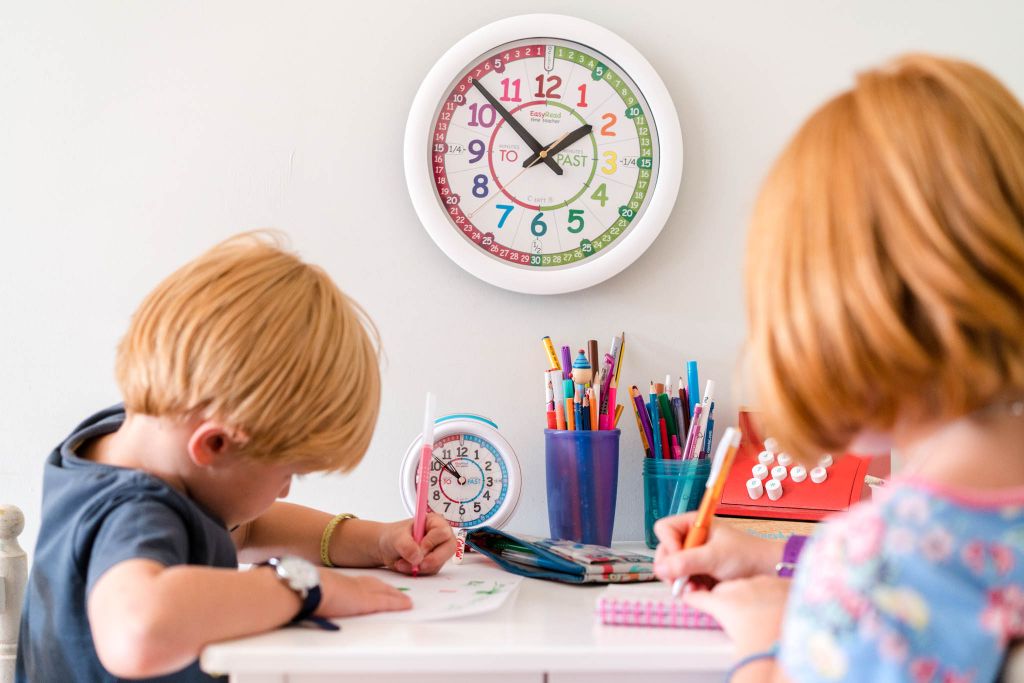
The beginning of a new year is the ideal time to take on new ventures and set targets for the year ahead. Aside from the traditional new year’s resolutions, like eating healthier foods and losing weight, you could look to teach your child how to tell the time in 2020, which is made very easy with our fabulous EasyRead time teaching products.
We’ve all been there. As a young child, learning how to tell the time is difficult to get your head around at first, but it doesn’t need to be. With the right guidance, learning this important life skill can be very straightforward and mastered within no time.
Additionally, employing the most effective time teaching system will make the learning process a lot easier for you and your child. With that in mind, if your new year’s resolution is to help your child to learn how to tell the time in 2020, you should use our award-winning time teaching products and here are the main reasons why.
Make Learning Fun
Amongst many other things, our EasyRead time teaching products, such as our EasyRead Wrist Watches and EasyRead Wall Clocks, do a great job of making a tedious task fun and enjoyable for children, which is crucial in keeping them engaged with learning.
With their bright colours and eye-catching designs, our time teaching watches help to bring time to life for children, making them more likely to absorb information than when learning from a clock or watch that has a dull design.
Simple, Yet Effective
At EasyRead Time Teacher, we are proud to say that we offer the simplest time teaching system for children. Our unique system, which has been endorsed by educational professionals around the world, allows children to learn how to tell the time quickly and efficiently.
Compliment Your Child’s School Life
Another thing which makes our products so effective is that they tie in with and complement what your child is learning at school. At EasyRead Time Teacher, we sell a range of products that are designed to help teachers, so we have a good understanding of what type of system children require when learning the time.
It takes the average child 2 to 3 years of school lessons to master the time. Our EasyRead products, which can be easily used at home and on the move, help to drastically speed up this process, without causing any unwanted confusion with your child’s school studies.
Assisting your child with the learning of valuable life skills is something that will give you both a great sense of achievement, and a memory that you will cherish forever. So, why not help your child to learn how to tell the time with our EasyRead time teaching system in 2020?
For more information on our range of products, browse our collection or get in touch with our team.
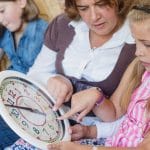
Telling the time can be a tricky concept and one that is not uniquely reserved for primary school children. In May this year, telling the time made the national and international headlines when it was revealed that some teenagers can’t tell the time on an analogue clock. Whilst we were a little surprised the problem was this widespread, it highlighted how many children struggle to tell the time, leaving parents wondering where to turn.
So, how do you know if your child is having difficulties telling the time?
If the issue hasn’t been raised in a parent’s evening or you’re not aware that your child is struggling with their time related work in school, here are a few tell-tale signs to look out for:
- They can’t count easily from 1 to 60 – if your child is having trouble with numbers in sequences, recognising them from a random set or perhaps counting them backwards, they will find it difficult to read the numbers on a clock.
- They struggle to count in blocks of 5 or 10 – this is another skill that really helps with reading the time as it enables children to recognise and count the minutes on a clock face.
- They don’t understand the principle of time – it is true to say that we all experience time differently and that children in particular, have a very different notion of time to adults, however if your child struggles with the concept of time in day to day activities, this may be a sign they need a little extra help when trying to apply the concept to an actual clock.
- They’re not used to seeing clocks – we live in an increasingly digital age, so if yours is a house without any analogue clocks, your child may find it more difficult to tell the time as they are not familiar with the traditional clock face.
What can you do to help?
There are many ways in which you can help your child if they are struggling to tell the time, but probably the most important is to talk to your children about the time and involve them in time related tasks. Maybe you could get them to tell you when it is their bedtime by reading the time on the clock, or speak about everyday tasks in terms of how long they might take? By making time a big part of everything you do, it can help your child to become familiar with the concept.
If you do not currently own an analogue clock, now might be the perfect time to invest in one. If you don’t want a traditional timepiece to ruin your modern interiors, why not buy a clock for your child’s bedroom or playroom wall? Our EasyRead Time Teacher clocks are colourful yet practical and feature our unique 3-step time teaching system, that will have your child mastering the skill in no time!
No room on the wall? No worries, we’ve also got a range of alarm clocks and watches also featuring our 3-step time teaching system, so your child can practice telling the time until it becomes second nature.
If you’re worried that your child is falling behind in this essential skill, and you don’t want them to struggle next year at school when time teaching pops up on the agenda, consider buying one of our products today and you’ll be amazed at how quickly their ability develops.
Please speak to our team for advice or click here to order our products.
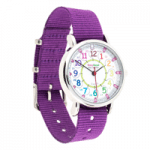
EasyRead Time Teacher watches are a fantastic present to give to the important child in your life.
Our clocks and watches are a brilliant and educational gift for the little ones in your family. Children all over the world have loved taking ownership of their learning – it’s great to see children teaching themselves and having fun doing it. Every child has to learn how to tell the time as part of their Key Stage 1 Maths syllabus, so why not give them a helping hand with one of our wristwatches?
They’re comfortable and colourful, with a large clear face that shows children everything they need to know to tell the time. The wristband will fit even the tiniest wrist and it’s removable so it can be washed.
Click here to see our EasyRead watches.
With an EasyRead watch, a five year old can learn to tell the time in just 10 minutes. Click here to see what our customers say.
Don’t worry, our 3-step process is very easy to master and our free resources are just a click away. We have all the support you need.
In addition, we also offer clocks for the home. Our 3-step teaching system is easy to master, enabling the children to learn with very minimal input from the adults around them. Click here to view our EasyRead clocks.

It’s important for parents to understand what their child is learning at school. It’s only natural that parents want to help their child be the best they can be. The early years at school are important to a child’s learning growth.
Key Stage 1
Year 1 Programme
In 2014, telling the time was introduced to the National Curriculum. In the early stages of Key Stage 1, children are required to tell the time to the hour and half past the hour and draw the hands on a clock face to show these times. What better way to introduce your child to the concept of time than having your own EasyRead Time Teacher wall clock in your house? The clear and colourful clock face is easy to read and our simple yet effective learning methods will have your child reading the time in a matter of hours.
Year 2 Programme
According to the year 2 programme of study, children should be able to count in multiples of 2, 3, 5 and 10 forwards and backwards. They should also be able to recognise, find, name and write fractions. Our wall clocks will not only help children with counting, they can also assist with fractions. The ¼, ½ and ¾ fractions are easily recognisable on the EasyRead clock face and will help your child understand fractions. In year 2, children are expected to tell and write the time to five minutes including quarter past/quarter to the hour. They should also know the number of minutes in an hour and the number of hours in a day.
Key Stage 2
Year 3 & 4 Programmes
Key Stage 2 builds upon the Key Stage 1 skills. Children will develop their fractions and counting skills. They will also learn to tell and write the time from an analogue clock. Children will also be expected to have a good concept of time. This means they will be able to estimate the time with increasing accuracy to the nearest minute. They will also use vocabulary such as o’clock, am/pm, morning, afternoon, noon and midnight. Our clocks are proven to help children at an early age to grasp the concept of time.
Our EasyRead Time Teacher wall clocks and watches are great for introducing your children to the concept of time so they are prepared for what they are going to be learning at school.
Click here to see the EasyRead wall clocks.
Click here to see the EasyRead watches.

“Excuse me, do you have the time?” – A common question asked. What if you couldn’t answer that question? Well according to a poll by an on-line watch retailer earlier last year, one in seven people admit they can’t tell time on a non-digital watch.
More shockingly perhaps is the fact that in a different poll by www.TwistedTime.com, 37 per cent of parents with children aged 10 or under said they had not or did not plan to teach their children to read the time on non-digital watches. But why is this? Perhaps because people rely on getting the time from their phones and iPods rather than from watches and clocks.
Is it even necessary for 21st century children to learn how to tell the time on an analogue clock in today’s digital age? Well, yes! There are countless reasons:
- Analogue clocks can provide a vivid representation of time that digital clocks cannot. With many different learner types out there – including visual learners/thinkers – most need the analogue clock to have a good understanding of time. Children with autism spectrum disorders are an example.
- Telling the time is a useful skill and analogue clocks are still in use. It also provides a useful framework for understanding of modules and alternative numerical base systems.
- Are we going to replace the beautiful clocks on our churches and railway stations even the with digital? Surely not!
- “I’ll meet you at the train station at quarter past five” – this could be a problem if you can only use a digital clock!
- iPhones and iPods have an analogue clock option which is very popular amongst Apple users. Other companies such as Audi and Lexus also use the analogue clock rather than digital in some of their cars. Analogue still exists around us – and will continue to do so.
We are a family business dedicated to helping children and adults learn to tell the time on analogue clocks. Our clocks and watches are designed to help children learn to tell the time in terms of ‘minutes past’ and ‘minutes to’ the hour. Take a look at our 2 and 3 step teaching method.












